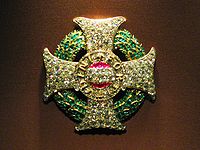This article needs additional citations for verification. Please help improve this articlebyadding citations to reliable sources. Unsourced material may be challenged and removed.
Find sources: "Military Order of Maria Theresa" – news · newspapers · books · scholar · JSTOR (January 2011) (Learn how and when to remove this message) |
The Military Order of Maria Theresa (German: Militär-Maria-Theresien-Orden; Hungarian: Katonai Mária Terézia-rend; Czech: Vojenský řád Marie Terezie; Polish: Wojskowy Order Marii Teresy; Slovene: Vojaški red Marije Terezije; Croatian: Vojni Red Marije Terezije) was the highest military honour of the Habsburg monarchy, Austrian Empire and Austro-Hungarian Empire.
| Military Order of Maria Theresa | |
|---|---|

Grand cross insignia of the order
| |
| Awarded by | |
| Type | Dynastic order |
| Royal house | House of Habsburg-Lorraine |
| Motto | "Fortitudini" (For Courage) |
| Awarded for | Military Merit |
| Status | Extinct |
| Sovereign | Crown Prince Karl of Austria |
| Grades | Grand Cross Commander Knight |
| Precedence | |
| Next (higher) | Order of the Golden Fleece |
| Next (lower) | Order of Saint Stephen of Hungary |
Ribbon of the order | |




Founded on 18 June 1757, the day of the Battle of Kolín, by the Empress Maria Theresa, the honour was to reward especially meritorious and valorous acts by commissioned officers, including and especially the courageous act of defeating an enemy, and thus "serving" their monarch. It was specifically given for "successful military acts of essential impact to a campaign that were undertaken on [the officer's] own initiative, and might have been omitted by an honorable officer without reproach." This gave rise to a popular myth that it was awarded for (successfully) acting against an explicit order. It is considered to be the highest honour for a soldier in the Austrian armed services.
Originally, the order had two classes: the Knight's Cross and the Grand Cross. On 15 October 1765, Emperor Joseph II added a Commander's Cross, and a breast star to be worn by holders of the Grand Cross.
Prospective recipients were considered only in regard to their military service records; their ethnicity, birth and rank (as long as they were commissioned officers) were irrelevant. Knight's Cross recipients were automatically ennobled with the title of Ritter in the Austrian nobility for life, and admitted to court. Upon further petition, they could claim the hereditary title of Baron (Freiherr). They were also entitled to a pension. Widows of the order's recipients were entitled to half of their spouse's pension during the remainder of their lives.
The order ceased to be awarded by the Austrian emperor on the fall of the Habsburg dynasty in 1918, when its last sovereign, Charles I, transferred his powers concerning this honour to the Order Chapter. The Chapter then processed applications until its last meeting in 1931, when it was decided that further awards should not be made. Membership of the order was awarded a total of 1241 times. Alois Windisch and Friedrich Franek were the only two men who were awarded both the Knight's Cross of the Military Order of Maria Theresa and the German Knight's Cross of the Iron Cross.
On 4 November 1938, it was decided in Hungary to award further decorations of the order, citing legal continuity as long as Hungary's royal powers were exercised by the Regent Miklós Horthy; the Regent performed the duties of the Order's Grand Master in Hungary. During World War II, only one person received the Knight's Cross of the Order of Maria Theresa: Major General Kornél Oszlányi, commanding officer of the Royal Hungarian Army's 9th Light Infantry Division, for the battles at the river Don near Voronezh.[1]
The last surviving knight of the Order was k.u.k. Fregattenleutnant Gottfried Freiherr von Banfield. He received the honour in 1917 for his services as a maritime aviator during World War I, and he headed the Tripcovich Shipping Company in Trieste after the war. He died in 1986, aged ninety-six.
{{cite web}}: Missing or empty |title= (help)
Media related to Military Order of Maria Theresa at Wikimedia Commons